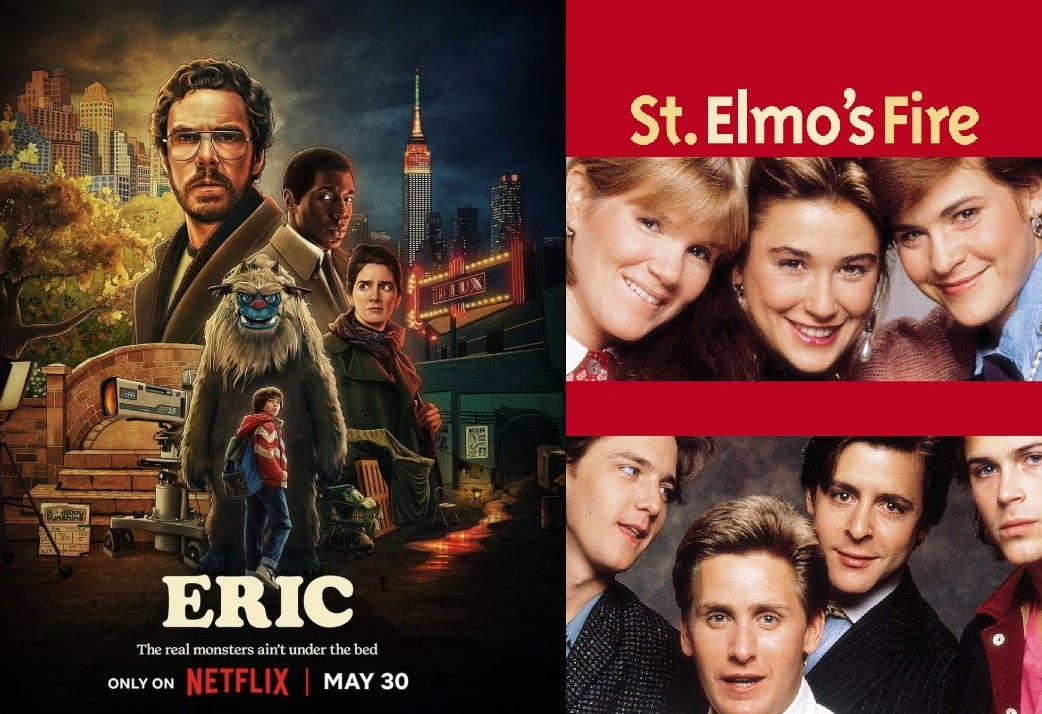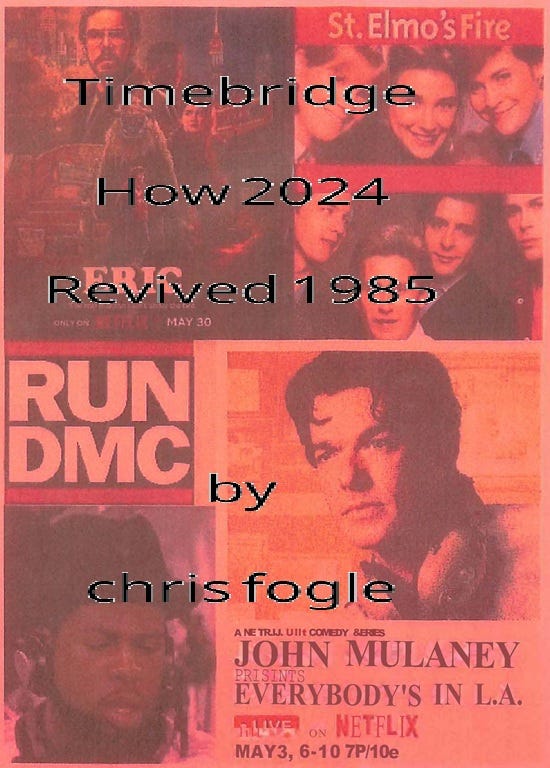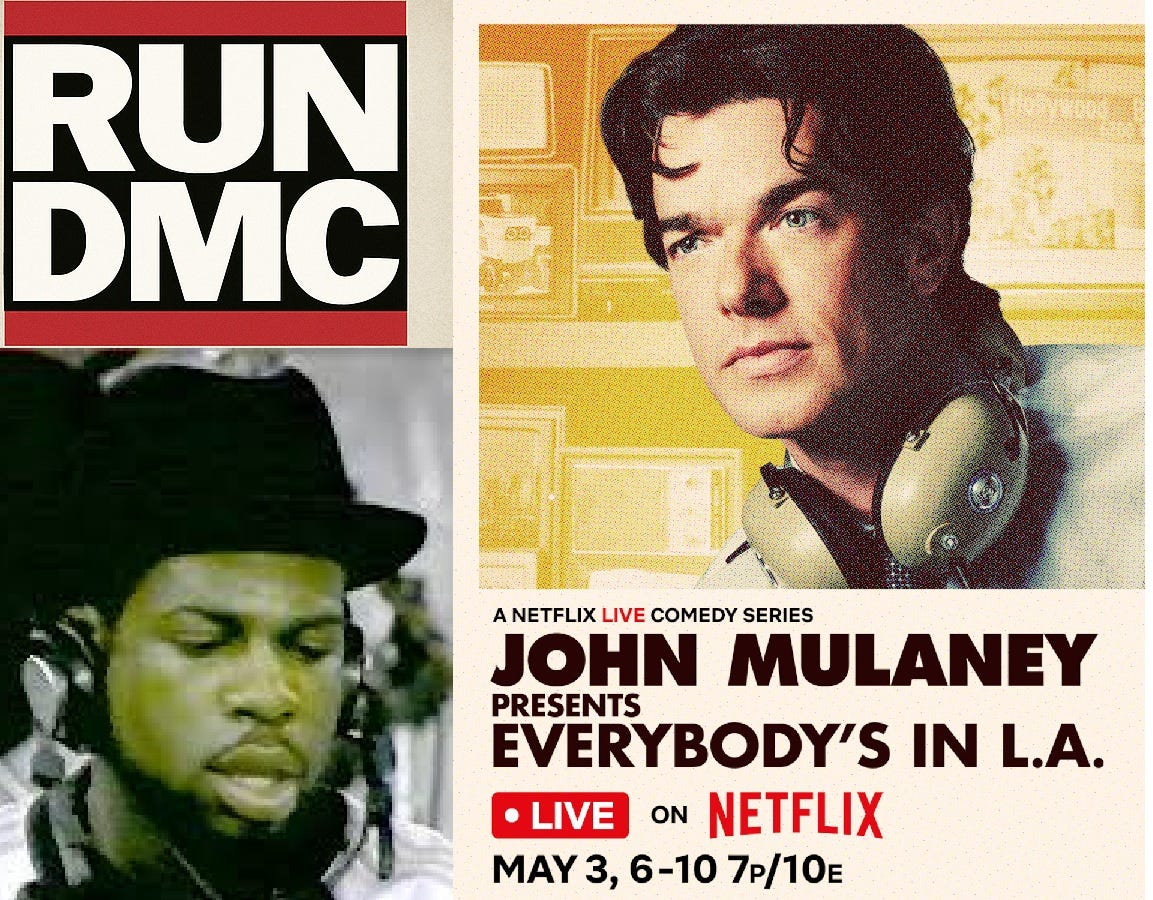Mini-Article: Timebridge
How 2024 Revived 1985. 11/10/25
Badalint-doont … badalint…bada..lint…
Yep, that’s an attempt at Wang Chung’s “To Live and Die in L.A.” and as those haunting yet hopeful first bars rang out on Everybody’s in LA, I knew the show would be distinctive. But the series was indicative of a deeper trend.
I believe the 2020s are consistently reviving, recycling, and reliving the ’80s. After all, that’s the premise of my annual comparison articles. But there is something truly unique about 1985 and there was a fascinating fixation on that year, specifically in 2024. We’ll explore why 1985 was such a pivotal year and why pop culture artifacts like To Live and Die in LA, Run-D.M.C., and the Brat Pack’s St. Elmo’s Fire, were celebrated. Seriously, if To Live and Die in LA had been written in 2024 it would have been called To Live and Revive in LA.
Kings From Queens: The Run DMC Story
King’s From Queens: The Run DMC Story (2024) is a three-part documentary about legendary rap group Run-D.M.C. Much of the story centers around 1985, including the film Krush Groove from that year. A concise statement on the importance of Run-D.M.C.’s 1985 album “King of Rock” and the documentary, is found in David Phillips’ article “Kings From Queens: the Long Overdue Story of RUN-D.M.C. on Peacock”:
As Ice-T states in the long overdue documentary about the legendary hip-hop trio, “The window of hip-hop relevance is so small,” and just two years later, with their follow up album “Tougher Than Leather,” hip-hop had moved away from their hard hitting boast rhymes and into the field of gangsta rap.
BONUS: Article: “MTV Firsts: Country, Rock, Rap, and Reality” from The Colorado Sound.
BONUS, BONUS: The above image of Jam Master J is from 1985’s Live Aid.
Everybody: is Both in LA and is Wang Chunging Tonight
As I wrote here, John Mulaney Presents: Everybody’s in LA explores the fact that LA is confusing, postulating that comedians and community experts can unravel the mysteries. The show used Wang Chung’s “To Live and Die in L.A.” as the theme song, and if you know Mulaney’s fastidiousness, it’s no surprise. (Coincidentally, Wang Chung was shocked but excited that Mulaney used their song.) Here’s an excerpt from a Hollywood Reporter interview:
Hollywood Reporter: And who chose To Live and Die in L.A. as the theme song?
JM: I did.
HR: Good choice.
JM: Thank you. I watched To Live and Die in L.A. because I’d been watching a lot of William Friedkin movies and read his autobiography during the making of the show. And as soon as I heard the song, I thought, “Oh my God, we have to get that.
HR: It’s so good. Wang Chung.
JM: A whole great soundtrack.
I really wanted to like the film To Live and Die in L.A. Parts were good, but it definitely doesn’t feel “essential” or like it deserves to be on a bucket list. For me, To Live and Die in L.A. the film could have died, but Wang Chung’s song – wow, I’m glad it lived! And initially critics agreed with me. But since then a growing base considers it to be ahead of it’s time.
And maybe this distinct ’80s feel, often compared to 1984’s Miami Vice, is why Wang Chung’s song feels “very” eighties, while maintaining relevance today. Mulaney could have only pulled this show together in 2024 for at least three reasons:
First, Mulaney is new to L.A. so he has fresh, investigative eyes. Second, the specific comedians who appeared were in town for 2024’s Netflix festival. And lastly, although Mulaney has always had a sophisticated wardrobe, and he took a run at nostalgic design in The Sack Lunch Bunch, it’s here on Everybody’s in LA, that ’80s reminiscence matches this cultural moment.

Netflix’s Eric
Set in 1985, Netflix’s Eric tells the story of generational trauma and the monsters we all have lurking in our closets. This was certainly the theme of my Christ and Pop Culture article “Eric: Bringing Light to the Darkness and Facing Our Monsters.” And specifically regarding the 1985 tie to 2024, I detailed:
When listing out the limited series’ newsworthy topics—like kidnapping, racism, homophobia, homelessness, and public sanitation—one might assume the storytelling is disjointed or bloated. It’s not. But 2024 culture is certainly comparable.
Consider jaded views of political candidates and corruption, a humanitarian heart for the unhoused, acceptance for the bullied, and empathy for mental illness. The writer’s empathy for societal issues, while also depicting filth and greed, is layered by characters attempting to do the same: bringing truth and light into darkness.
It also seemed fitting that the Eric trailer features a 2024 cover of ABBA’s “S.O.S” by Nari and Steve Tosi.
Hulu’s Brats
The documentary Brats highlights St. Elmo’s Fire (1985) and initial use of the term “Brat Pack” in 1985. Andrew McCarthy, one of the Brat Pack, directs and stars in the film, saying, “Hollywood discovered the box office potential of a young audience. They aimed their money-making tractor beam directly at it.”
The shot immediately cuts to a newscaster explaining, “It’s the Hollywood class of 1985, a crop of young movie actors that’s giving young audiences a whole new generation of heroes to root for.” McCarthy follows up, “And then on June 10, 1985, New York Magazine published a story called ‘Hollywood’s Brat Pack.’”
But the influence of the term and the time can’t be overstated. Most of the Pack members hated the expression and felt it damaged their careers. McCarthy asked Malcolm Gladwell, author and social critic, his thoughts on the anomaly. Amidst a fascinating interview, Gladwell explains that the obvious take on the Rat Pack coincided with “youth movies” taking over.
Brat Pack alum Rob Lowe agrees: “…the movie business was beginning to transition to where it landed and still exists, which is movies made almost exclusively for 18- to 20-year-olds. I mean, every summer movie that’s out is geared towards that audience. It wasn’t always like that.” McCarthy concurs but tries to pump the breaks on the group’s fame, saying, “Well, we didn’t fill Shea Stadium, but I mean there were moments (laughing).”
Lowe argues: “We could have. 1985, I think we could have. It was fun, excitement, the world is your oyster. You can’t believe what’s happening, confusion. And it was at the height of the Brat Pack, and it was super unbelievable.”
So 1985 and the Brat Pack changed the movie industry but it’s always evolving, right? In some ways, yes, yet Maxwell argues that this specific change could have only happened in the mid-eighties and, maybe more importantly, that it could not happen now. Here’s my transcription of the conversation:
Gladwell: Well, [it’s] possible then in a way it’s not possible now. So nothing like that can happen anymore. You can’t have a cultural touchstone that everyone in their 20s can refer to. If you gathered one hundred 17-year-olds at random in America in 1986, 90 would have seen, or at least be conversant about Pretty in Pink. No question. They wouldn’t even have to see it to be able to hold a conversation about it.
McCarthy: Right.
Gladwell: There is absolutely no cultural phenomenon at the present time of which that can be said – impossible.
McCarthy: Why?
Gladwell: Well, because things have been fractured. We’ve gone from a relatively unified youth culture to a youth culture that looks like every other aspect of American society, which is everything’s all over the place. There’s no common denominator.
I find it fascinating that as interwoven as we are with the ’80s, we can’t have another redefining moment like the Brat Pack. Maybe our current culture alarms us because we are nostalgic for a time (even if we didn’t experience it) that we subconsciously know we can never return to. Or maybe we who can’t afford rent…or groceries or gas in the mid-2020s can’t relate to the St. Elmo’s Fire characters who are depressed because they have…jobs and housing. Yep, bring in the therapists.
BONUS: Watch John Parr’s tasty little music video “St. Elmo’s Fire (Man in Motion).”
Peacock’s Gary
Gary, a 2024 documentary about Gary Coleman, covers his life and career. It’s a sad story examining Coleman’s desire for companionship and meaningful roles. Dion Mial, friend and business manager, said, “When Gary was seventeen as well as his poor health, he was not comfortable with the fact that the character of Arnold Jackson was not aging at the same pace that Gary Coleman was aging.”
A scene from 1985 portrays Gary as a little kid needing his dad to drive him to school (Season 6 of Diff’rent Strokes). Eve Brandstein, Diff’rent Strokes casting director, notes that the network didn’t want to change their golden goose. “That caused him pain emotionally, I’m sure.” Cut to The Tonight Show with Joan Rivers, 1985 where Rivers asks, “Are they maturing you on the show?” Gary scowls, “Not much.” Rivers questions, “Are you complaining?” Without hesitation, Gary replies, “Of course,” shrugs, “not much I can do about it…yet.”
Runner Up’s
There were a few runner’s up that I didn’t have time to watch or fully research:
Modula Font
Tom May says, “Designed by Zuzana Licko in 1985, Modula was the first high-resolution headline typeface created using a Macintosh, during a time when most digital font creation focused on mechanical digitization of traditional typefaces.”
BONUS: See the full article “The best typography of the 1980s, as chosen by design experts” on Creative Bloq.
When God Introduces a High-Resolution Headline Typeface on a Mac, He Opens a Window(s)
Microsoft released Windows 1.0 in 1985. Check out Medium’s 2024 article here.
Every Minute Counts
A limited series about the 1985 earthquake in Mexico City.
Conclusion
I can’t be 100 percent sure why 2024 focused so heavily on 1985 but here’s a SWAG. Some of it had to do with the right timing for the stories to be told, as I believe was true for the documentaries Brats and Gary. Some of it had to do with 1985’s litany of touchstone pop culture (Some of which we didn’t cover such as Back to the Future, The Breakfast Club, and Madonna’s “Like a Virgin”).
And according to the Los Angeles Sentinel, there were two primary reasons why the Run-D.M.C. documentary was made in 2024: (1) biopics were popular in 2024, and (2) Darryl “DMC” McDaniels wanted to strategically tell the group’s story in a doc to leverage the aforementioned trend for a future, scripted opportunity.
By the middle of the decade there was a sound, look and attitude already defining the era. That means shows like Eric could be set in 1985 and use a plethora of period accurate pop culture. And for partially scripted shows like Everybody’s in LA, design choices could be made to use the very best of what the mid-eighties had to offer. (I’m pretty sure Mulaney and NPR commissioned David Lynch to design a waiting room as the set – that was a joke, but the set is pretty perfect.)
So maybe 2024 didn’t revive 1985, maybe we just syndicated it.



